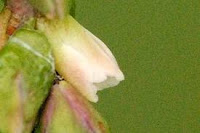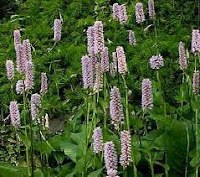Horsemint is a wild mint and related to garden mint and as a member of the mint family is also related to purple, yellow and white dead nettles, marsh woundwort, the teak tree, marjoram, basil, Holy basil, oregano, savory, thyme, lavender, lemon balm, Scarlet bee balm as well as bugle, motherwort, self-heal, catnip, the chaste tree, ground ivy, Jupiter’s sage, wall germander, Fragrant premna and hyssop. It is native to Europe including Britain Siberia . The leaves are used both as a tisane and a condiment, as well as being eaten raw in salads or cooked as a flavouring for dishes, just like garden mint.
 If you plant it near cabbage or tomato plants in your garden it will keep them free of insects pests and rats and mice hate it too which is why it was once used as a strewing herb in granaries and homes.
If you plant it near cabbage or tomato plants in your garden it will keep them free of insects pests and rats and mice hate it too which is why it was once used as a strewing herb in granaries and homes. The leaves and flowering tops may be used in a tisane either fresh or dried, and added to green tea, really improve its flavour. The stem, leaves and flowering tops have stimulant, antispasmodic, anti-asthmatic and carminative properties, so it is a good aid to digestion, and can cure flatulence. The leaves bear an essential oil which is a good antiseptic. It is used as a food flavouring as it has a peppermint flavour.
Nicholas Culpeper the 17th century English herbalist had this to say of horsemint:-
“It is good for wind and colic in the stomach.... The juice, laid on warm, helps the King's evil or kernels in the throat.... The decoction or distilled water helps a stinking breath, proceeding from corruption of the teeth, and snuffed up the nose, purges the head. It helps the scurf or dandruff of the head used with vinegar.”
The tisane has been used for headaches, stomach problems, and fevers, but it is not advisable to take it in large doses if pregnant. It is a good remedy for diarrhoea and on study has supported this use; “Calcium channel blocking activity of Mentha longifolia L. explains its medicinal use in diarrhoea and gut spasm” Shah, A. J. et al. Journal of Phytotherapy Research, 2010 Vol. 24 (9) pp. 1392-97. This study concludes that it showed “indirect evidence for its medicinal use in diarrhoea and spasm.”
 Other research studies have shown that it has antibacterial properties Rahmat Ali Khan et al.2011 African Journal of Pharmacy and Pharmacology Vol. 5 (12) pp. 1530-32 “Phytotoxic and antibacterial assays of crude methanolic extract of Mentha longifolia (Linn.)” Also in another study the apigenin derivatives (flavonoids) found in the plant were discovered to have antimutagenic properties; Ozlem Baris et al. Journal of Food Science, Nov-Dec 2011 Vol76 (9).Yet another study published in 2011 found that horsemint does help symptoms of Irritable Bowel Syndrome, and it was superior to nut grass (Cyperus rotundus) in it action.(Ahmed Salih Salib et al.) Another study published in 2009 has confirmed its antimicrobial properties and so supported its use for the treatment of mouth ulcers and other oral problems. (Firas A. Al-Bayedi)
Other research studies have shown that it has antibacterial properties Rahmat Ali Khan et al.2011 African Journal of Pharmacy and Pharmacology Vol. 5 (12) pp. 1530-32 “Phytotoxic and antibacterial assays of crude methanolic extract of Mentha longifolia (Linn.)” Also in another study the apigenin derivatives (flavonoids) found in the plant were discovered to have antimutagenic properties; Ozlem Baris et al. Journal of Food Science, Nov-Dec 2011 Vol76 (9).Yet another study published in 2011 found that horsemint does help symptoms of Irritable Bowel Syndrome, and it was superior to nut grass (Cyperus rotundus) in it action.(Ahmed Salih Salib et al.) Another study published in 2009 has confirmed its antimicrobial properties and so supported its use for the treatment of mouth ulcers and other oral problems. (Firas A. Al-Bayedi) Scientists in the West, where the use of herbal medicine had largely fallen into disuse are lagging behind those scientists in countries where herbal medicine is still used in discovering alternatives to pharmaceutical drugs.

















































